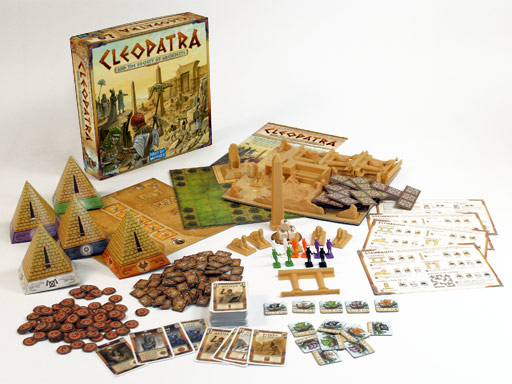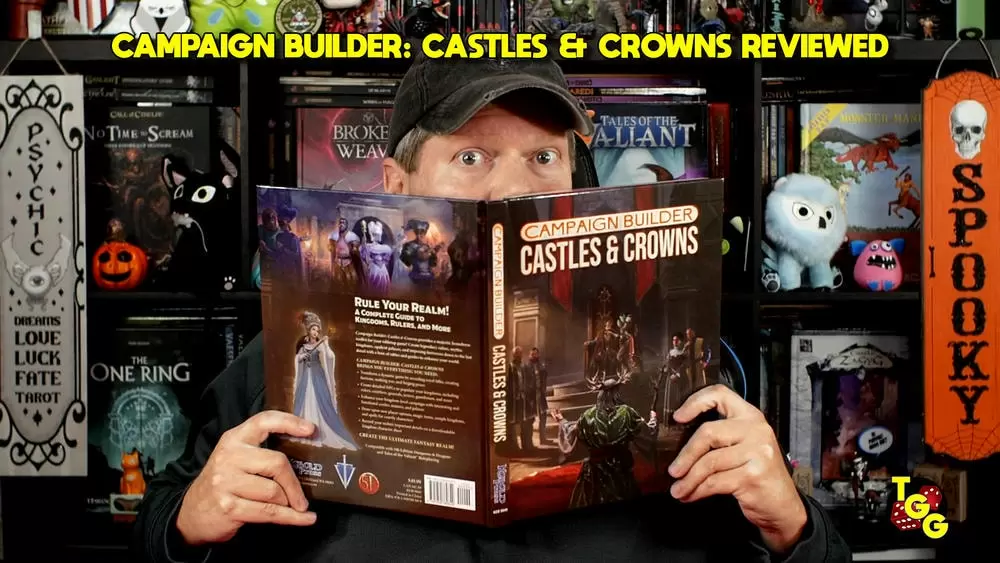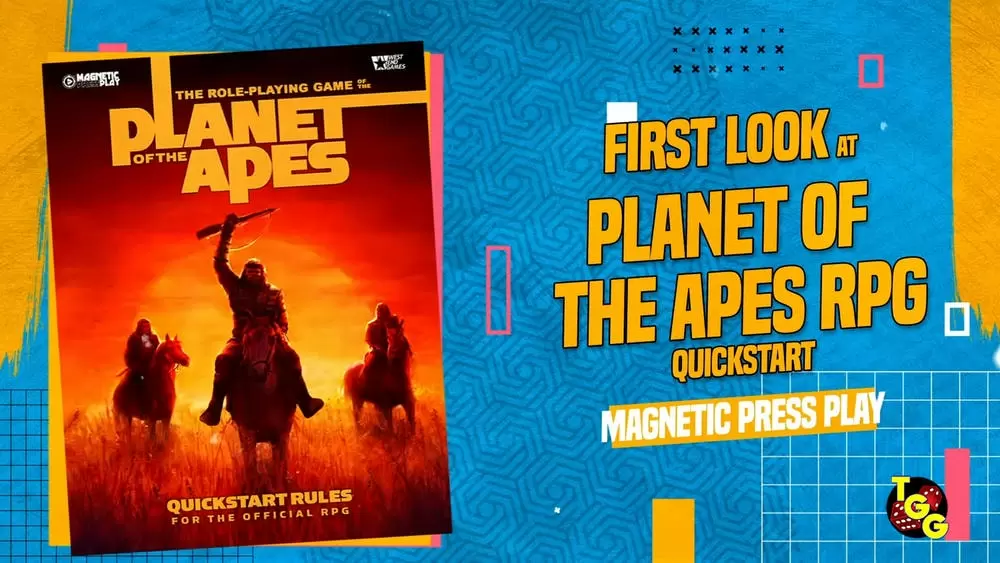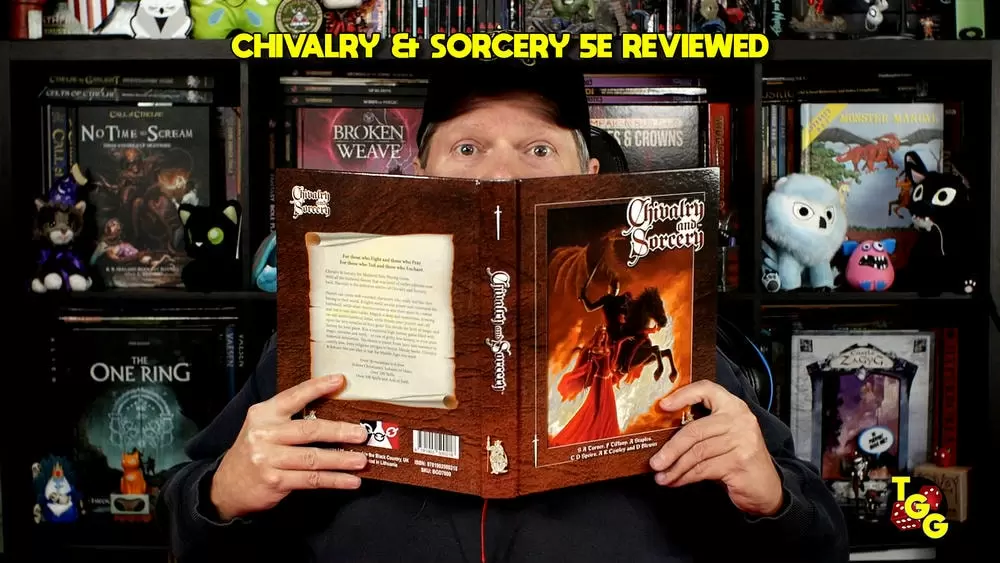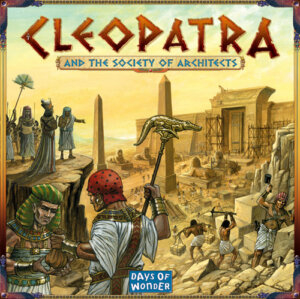
Publisher: Days of Wonder
Designers: Bruno Cathala and Ludovic Maublanc
Year: 2006
Players: 3-5
Ages: 10+
Playing Time: 60 minutes
Retail Price: $50.00 (English edition is OOP but can be found online for $20-$30)
Category: Family hand management strategy
Contents:
- An entire 3D Palace, complete with 9 Column walls, 2 Door frames, 2 Obelisks, 6 Sphinxes, 1 Throne and 1 Pedestal, and 10 Statues of Anubis
- 108 Talents from the Treasure of the Pharaoh
- 89 Amulets of Corruption
- 110 Resource and Character cards
- 1 Sculpted figure of Cleopatra
- 5 Pyramids of Corruption
From Days of Wonder:
“The object of the game is to become the wealthiest of Cleopatra’s architects, by constructing the most magnificent and valuable parts of her Palace.
Given the intense competition that reigns among the members of the Society of Architects, you will often be tempted to deal with shady characters and trade in materials of dubious origins.
While these corrupt practices may indeed allow you to stay a step ahead of the pack, they come at a heavy price: Cursed corruption amulets honoring Sobek, the Crocodile-god, which are stored inside your Pyramid of Corruption, hidden from the preying eyes of your competitors.
When Cleopatra finally strolls into her new Palace, at the end of the game, the most corrupt architect (the one with the most amulets) will be seized and offered to her sacred crocodile as a tasty morsel! Only then will the wealthiest architect, from among those still alive, be selected and declared winner of the game.”
***
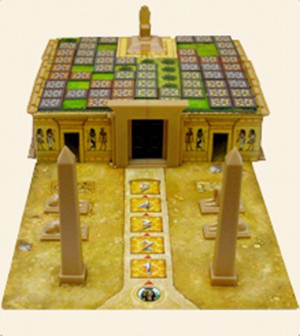
One thing about CSA which immediately catches your eye is the box bottom, flipped upside down, is used as the foundation to build upon. Yep, you’ll be building the Column Walls and Door Frames around the box bottom while the Throne, Pedestal, and Mosaics of the Gods on top. The Obelisks and Sphinxes have their own board to be built on, right next to the box. It’s cool to see the temple being built and makes you feel like you are creating something from scratch (one more reason I use this game).
To build these Egyptian wonders you will need resources which are in the Market. Cards represent the five different resources, from common to rarest; Artisan, Stone Block, Marble Slab, Wooden Log and Lapis Lazuli. There are three stalls in the Market along with a draw deck. On your turn you may take all the cards from one stall. While setting up the Market, with new players, every time someone tells me to stop right before I shuffle the cards. Why? You take half the deck face up, the other half face down and shuffle. Once again introduces players to new mechanics of playing board games. When a player is done visiting the Market you will replenish each stall from the draw pile. Some cards will be face up and some face down. Maintaining their orientation, from the draw deck, when placing them is important.
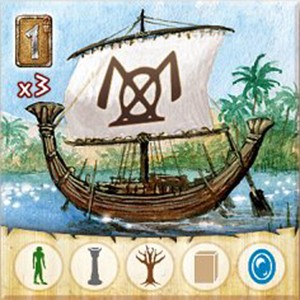
I’ve played CSA over ten times and have only had to make an offering once. This one part of the game adds a bit of tension to allow players a way to remove Amulets of Corruption from their Pyramids.
The Amulets of Corruption will be a part of the game that will affect who ends up the winner. Among the regular resource cards are “Tainted” Resource and Character cards. The Tainted cards give you more resources or special actions, but you also collect Amulets of Corruption. At the end of the game the player or players with the most Amulets cannot win. This part of the game introduces players to thinking about the long term strategy of CSA. It’s exciting and funny to see someone realize they forgot about that rule half way through the game. For me it’s always a good place to laugh and talk amongst ourselves about trying different strategies. After all this is what playing board games are all about; having fun and making new friends as you socialize all the while.
Once five of the six monuments are fully built the game ends. Time to count up those Amulets of Corruption, see who was the most corrupt and feed them to the crocodiles! Everyone is amazed over the number of Amulets they have in their pyramid. Every game you hear “There’s no way I have that many.”, “Who added tokens to my pyramid?”, “I knew I should have taken more Amulets.” The players which are still alive count up their Talent points and the one with the most is the winner.
Cleopatra and the Society of Architects is worth the time and effort to locate a copy for your collection. The components and artwork are all well done and when you lift the game box you feel like you’ve gotten your money’s worth, especially for those new to gaming.


